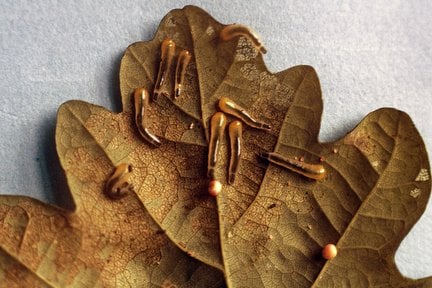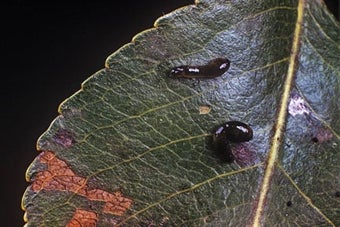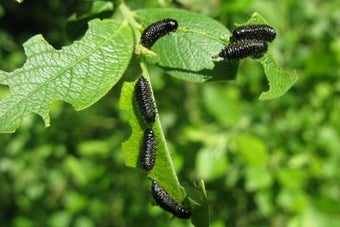
Quick facts
Common name - Oak slug sawfly or slugworm
Scientific name - Caliroa annulipes, C. cinxia and C. varipes
Plants affected - Oak (Quercus) and lime (Tilia) trees
Main symptoms - The surface of leaves is grazed away these areas dry up and turn brown
Most active - Summer
What is oak slugworm?
Oak slugworms are the larvae of a three species of closely relatedy. The adult sawflies have black bodies about 7-8 mm long and two pairs of blackish transparent wings, they emerge during spring. They are part of the healthy trees support.
Eggs are laid on the foliage and they hatch into larvae that are pale green with a slimy slug-like appearance. Their bodies are translucent and the gut contents can often be seen as a dark green line inside the body. The larvae grow to a length of about 12 mm and are somewhat club-shaped with the head end being swollen. When fully fed the larvae go into the soil to pupate.
There are two generations of larvae a year between May and August. The second generation in mid to late summer can be the most noticable. In some years there is a third generation of caterpillars in the autumn. Larvae that complete their feeding late in the year overwinter in cocoons in the soil and adults emerge in spring the following year.
Sawflies are in the same group of insects as bees, ants and wasps (the Hymenoptera). They have caterpillar-like larvae that feed on plants the adults are winged insects that can appear fly-like. More than 500 species of occur in Britain, you can find out more about these insects from .
Symptoms
The larvae do not make holes in the leaves but graze away the leaf surface until only the epidermis remains. Damaged areas dry up and become white or pale brown; this type of damage is sometimes known as window paning.
This species is primarily found on oak (Quercus) and lime (Tilia) trees. Occasionally birch (Betula) and willow (Salix) trees are also hosts.
Other species of slugworm cause similar effects on pear , cherry , and roses .

Management
Oak slugworm is part of the healthy host trees support. Heavy populations are uncommon and although the damage to trees may appear alarming, the tree will survive and in the year following a heavy damage, they will usually produce normal leaves. There is unlikely to be any long term effect on the tree's health.
- Encourage predators and other natural enemies of in the garden, such as birds , ground beetles and wasps ; in most years these will keep slugworms at a relatively low level















